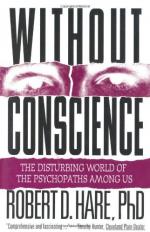
|
| Name: _________________________ | Period: ___________________ |
This test consists of 5 multiple choice questions, 5 short answer questions, and 10 short essay questions.
Multiple Choice Questions
1. What group is a frequent source of victims for psychopaths?
(a) Lonely women.
(b) Naive women.
(c) Older women.
(d) Unmarried women.
2. For the psychopath, crime is a natural result of what?
(a) A tragic childhood.
(b) The confidence of foolish people.
(c) Opportunities all around.
(d) A deviant personality structure.
3. How do psychopaths tend to view therapists?
(a) As surrogate family.
(b) As their only hope.
(c) As friends and supporters.
(d) As objects to be conned.
4. Why did one psychologist run off with her psychopathic patient?
(a) She believed his promises.
(b) She wanted to do field work on his methods.
(c) She was trapping him into revealing himself.
(d) She was studying his case.
5. How are psychopathic children distinguished from normal kids?
(a) They are overindulged by their parents.
(b) They are more intelligent.
(c) They are cuter and more likely to be spoiled.
(d) They are more difficult and harder to understand.
Short Answer Questions
1. In how many cases did Dr. Grigson's expert testimony result in the death of defendants?
2. What effect does parental behavior have on psychopathy?
3. How is psychological denial useful?
4. What does successful therapy require of a patient?
5. What did Dr. Jerrold Post predict that Saddam Hussein would do?
Short Essay Questions
1. Why are many clinicians and family members reluctant to identify psychopathy in childhood?
2. What benefit does a psychopath typically get from therapy programs?
3. Why does Kiki Olson say that the inclusion of more women in the workforce has opened new pathways for psychopaths?
4. Why does the author say it is important that everyone learn how to deal with psychopathy?
5. Why is the option of ignoring the presence of psychopathy in children no longer available?
6. Why is the typical advice to quit indulging misbehaving youth and get them into therapy considered by the author to be doomed to failure?
7. How have family members often unwittingly contributed to a psychopath's misbehavior?
8. Why is it important to identify psychopathy in childhood?
9. What does the Psychopathy checklist provide to clinicians that they are lacking?
10. Why does the author think it important to know about the eyes of a psychopath?
|
This section contains 980 words (approx. 4 pages at 300 words per page) |

|




